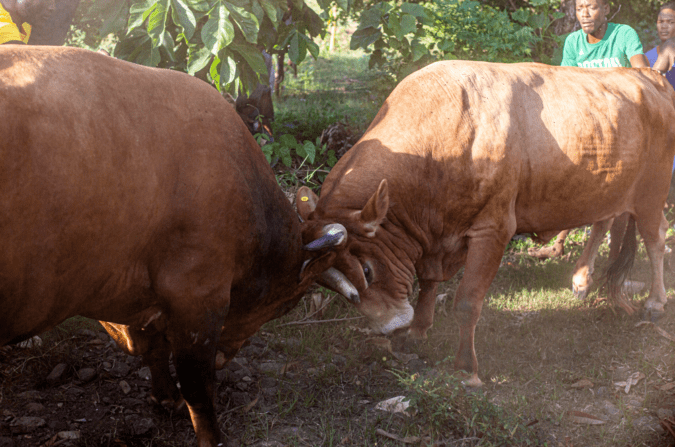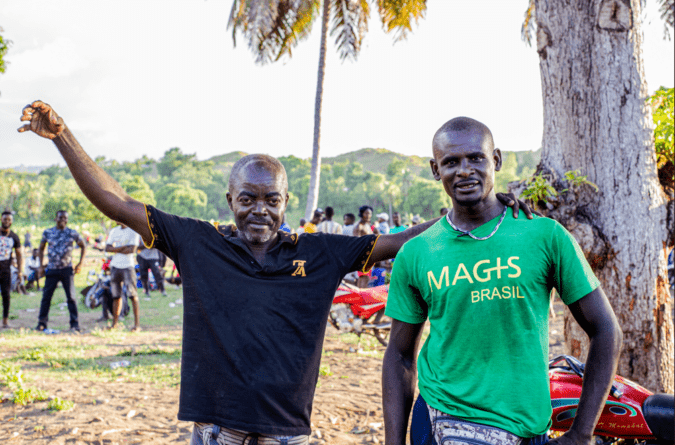Bulls take on special names based on their fierceness with namesakes like Muscadin, Village de Dieu, Ti Magali…
The sharp fangs of the two sweating bulls collide brutally. The animals retreat then charge towards each other again.

In the atmosphere of an ecstatic crowd in Léogane, two bulls named Ti Magalie and Muscadin engage in a final, merciless battle. | © David Lorens Mentor/AyiboPost
Around the red eyed animals, an agitated crowd cheers, some patting the flanks of their favorite animal, others shouting predictions on the outcome of this battle of horns, flesh and brute force.

A crowd, mostly composed of men, is eagerly awaiting a fierce bullfight in Léogane. | © David Lorens Mentor/AyiboPost
These particular fights take place regularly in Léogâne. They give the population a reason to enjoy “clairin” (a traditional Haitian spirit made from sugarcane), but above all, they allow local fans and even the diaspora to bet considerable sums on their favorite four-legged boxers.

Robenson Pierre and Verion are the two main organizers of the Oxen fight in Léogâne. | © David Lorens Mentor/AyiboPost
Bets regularly amount to several hundred thousand gourdes. “It’s very profitable,” adds Nickenson Casséus, a farmer from Delande who has participated in these animal competitions for several decades.
Some go so far as to count on these fights for the start of the school year. “This helps me pay for my children’s schooling,” says Marie Claude Toussaint, a teacher and merchant who has been selling drinks in the locality for eight years.

In addition to this bullfighting competition, a horse meat vendor takes advantage of the opportunity to serve the attending crowd. | © David Lorens Mentor/AyiboPost
The clashes take place under collateral or in “Dezafi”.
At the final stage, the animals fight without any prior agreement. Along with the money from the wagers, the rewards can be goats, bags of rice, pigs, gallons of oil…
The first requires the provision of a deposit to a trusted person, a judge. The party who doesn’t show up with their animal loses the deposit. And during the fight, the animal that dies or flees is defeated.
Bulls intended for fighting are bred for this purpose. There are even lineages known for their ferocity.
Animals take on special names based on their fierceness with namesakes like Muscadin, Village de Dieu, Ti Magali, etc.
Supporters must not touch or wet the animals during fights, but it remains difficult to enforce this rule, as the participants are often agitated.

A fight lasting over 5 minutes between Ti Magali and Muscadin. | © David Lorens Mentor/AyiboPost
AyiboPost tried unsuccessfully to find research tracing the origin of this practice in Haiti. However, it is very popular in different places around the world, such as South Korea, the Balkans, South America, Turkey and the Persian Gulf.
In Japan, on the southern archipelago of Okinawa, bullfighting has been a tradition in local culture for some 800 years. This sporting spectacle, known as « ushi orase », attracts audiences ranging from the very old to the very young.
In the Phù Ninh region in northern Vietnam, buffalo fights take place every year, on the 9th day of the 8th lunar month, for a traditional festival in honor of the water divinity, Diêm Tuoc. Once the fight is over, the winning buffalo will be immolated as a sacrifice to the divinity. The other livestock that fought will also be sacrificed and then consumed because according to tradition this brings good luck.
[metaslider id=53114]
By Jérôme Wendy Norestyl & David Lorens Mentor
English translation by Sarah Jean.
Cover Image: During a bullfight in Léogane in September 2023, an enraged bull charges towards the trunk of a tree. | © David Lorens Mentor/AyiboPost
Stay in touch with AyiboPost through :
► Our WhatsApp channel : click here
► Our WhatsApp Community : click here
► Our Telegram canal : click here







Comments